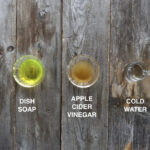Fruit flies, those tiny, persistent insects that seem to materialize out of thin air around your fruit bowl, are a common household nuisance. Scientifically known as Drosophila melanogaster, these “dew-loving” creatures are drawn to ripeness and decay. Their sudden appearance often leads to questions about their nature, and one common concern is: Are Fruit Flies Poisonous?
Debunking the Poison Myth: Are Fruit Flies Directly Poisonous?
The short and reassuring answer is no, fruit flies are not poisonous in the way you might think. They do not possess venom and cannot sting or bite in a manner that injects toxins into humans or pets. Unlike some insects that use poison for defense or predation, fruit flies are primarily interested in consuming and reproducing around fermenting organic matter.
The concern about them being “poisonous” likely stems from their association with decaying food and the general unease people feel around infestations of any kind. However, it’s important to differentiate between being poisonous and being vectors for less desirable things.
The Real Concerns: How Fruit Flies Can Indirectly Affect Your Health
While fruit flies are not inherently poisonous, they can pose indirect health concerns due to their habits and the environments they frequent. Here’s how:
- Contamination: Fruit flies thrive in unsanitary conditions, feeding on rotting fruits, vegetables, and other decaying organic materials. This means they can pick up bacteria and pathogens on their bodies and legs. When they land on your food, they can transfer these contaminants, potentially leading to foodborne illnesses if you consume the contaminated food.
- Spread of Bacteria and Yeast: Fruit flies are known to carry various types of bacteria and yeast. While not all of these are harmful, some can contribute to food spoilage and potentially cause digestive upset if ingested in large quantities.
- Allergenic Potential: For some individuals, fruit flies can be an allergen. Exposure to fruit flies or their waste products might trigger allergic reactions in sensitive people, although this is less common than allergies to dust mites or pollen.
- Nuisance and Hygiene Indicator: The mere presence of fruit flies is often an indicator of poor hygiene or overlooked food waste. Their proliferation signals that there are readily available breeding grounds, which can attract other pests and create an unsanitary environment in your home.
It’s crucial to understand that the issue with fruit flies isn’t about them being directly poisonous, but rather their role as potential vectors for contamination and indicators of hygiene issues.
Identifying Fruit Flies: What Do They Look Like?
To better understand these tiny pests, it helps to know what they look like:
Adult fruit flies are small, typically about 0.12 inches long and 0.08 inches wide. They have a characteristic tan or brownish-yellow body, though some can be darker. Key features include:
- Red Eyes: Most fruit flies have distinct red eyes, a helpful identifying characteristic.
- Rounded Body: They have a somewhat rounded body shape compared to the thinner bodies of gnats.
- Antennae: Like other flies, they have small antennae on their heads.
- Single Pair of Wings: They possess one pair of wings, typical of flies.
It’s easy to confuse fruit flies with gnats. Gnats tend to be darker, often black, and have thinner bodies compared to fruit flies.
Fruit flies are attracted to and feed on fruits, especially overripe or fermenting ones. They also consume rotting vegetables, wine, beer, vinegar, and fruit juices. Larvae feed on the same food source where they are laid.
Why Are Fruit Flies Attracted to Your Home?
Fruit flies are drawn to homes because they provide ideal breeding and feeding grounds. The primary attractants are:
- Overripe Fruits and Vegetables: Left out on counters, these are prime targets.
- Fermenting Liquids: Spilled wine, beer, juice, and even vinegar attract them.
- Garbage and Food Waste: Unsealed trash cans or compost bins are breeding havens.
- Drains and Damp Areas: Sinks and drains with food residue can also attract them.
Even seemingly untouched fruit can be a breeding site, as fruit flies sometimes lay eggs on unripe fruit, ensuring a food source for hatched larvae.
Preventing and Managing Fruit Flies
Since fruit flies aren’t poisonous but can be vectors for contamination and indicate hygiene issues, controlling them is important. Prevention is the most effective approach:
- Store Fruits and Vegetables Properly: Refrigerate ripe produce or store them in sealed containers.
- Clean Up Spills Immediately: Wipe up any spills of sugary liquids, juice, wine, or beer.
- Empty Trash Regularly: Don’t let garbage accumulate, especially food waste.
- Clean Drains: Regularly clean sink drains to remove food buildup.
- Use Fruit Fly Traps: Simple traps using vinegar or wine can effectively capture adult fruit flies.
Conclusion
In conclusion, fruit flies are not poisonous insects. They do not bite, sting, or inject venom. However, they are unhygienic pests that can carry bacteria and pathogens from unsanitary environments to your food. While they pose a low direct health risk, their presence is a sign of potential hygiene issues and food contamination risks. Focusing on prevention and proper food storage is the best way to manage fruit flies and maintain a clean and healthy home environment.
Note: Please replace image_url_fruit_flies.jpg with the actual URL of an image of fruit flies on fruit. If you cannot find a suitable image, you may omit the image insertion.
